Kitchen Pantry: Layout, Design, and Organizing Solutions
- modersyinterior
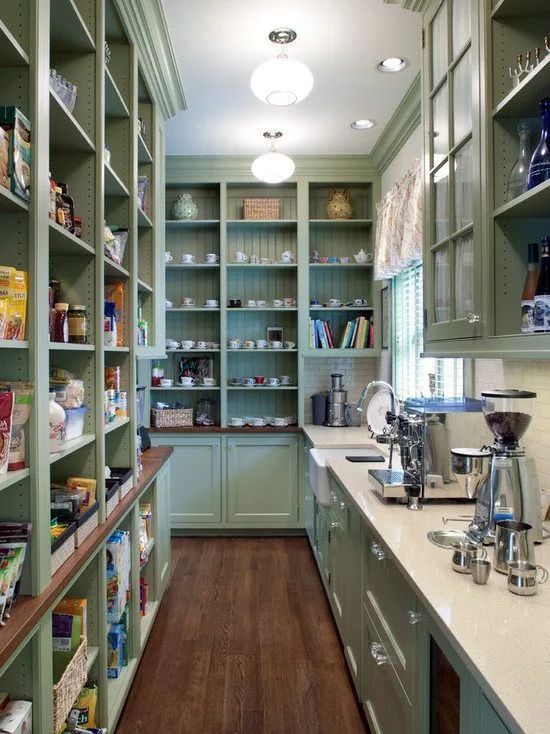
Many people grapple with a challenging decision: whether to construct an independent pantry in their kitchen or to suffice with cabinets. Each option has its merits. A designated pantry, whether a separate room or an integrated cabinet, enhances the organization of various items such as long-term storage goods, fruits and vegetables, canned foods, kitchenware, and appliances.
An effectively planned pantry layout can be surprisingly spacious, helping maintain impeccable order in the kitchen space.
Before embarking on building a pantry or acquiring a pre-made pantry cabinet, assessing your specific wants and needs is essential. Consequently, the size and internal arrangement of the pantry should be customized to fit your requirements.
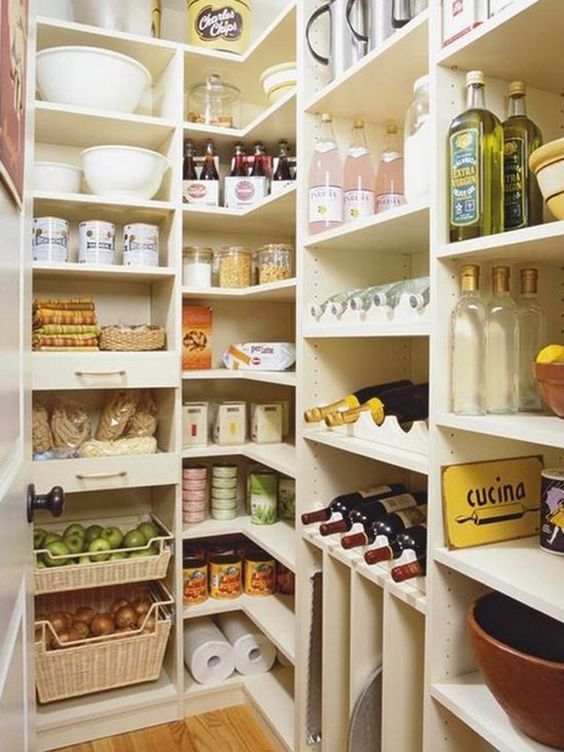
Advantages and Disadvantages of a Kitchen Pantry

Having a pantry space, be it a separate room near the kitchen or a spacious pantry cabinet, presents several significant benefits.
- A built-in pantry or a tall cabinet is spacious yet consumes minimal valuable area. Every inch is efficiently utilized with intelligent organization using shelves, drawers, hanging systems, and other storage solutions.
- This setup allows homeowners to buy groceries in bulk, saving time on frequent store visits and often benefiting from bulk purchase discounts.
- For those who enjoy home canning, a pantry provides ample space for storing jars and containers of preserves. The storage can be enhanced with sliding and wicker baskets and drawers.
- The pantry is also ideal for storing wine and spirits and can house an additional fridge or freezer if space allows.
- A separate pantry can significantly declutter the kitchen, making it appear more open and airy. This could eliminate the need for numerous overhead cabinets, freeing up space for a comfortable dining area.
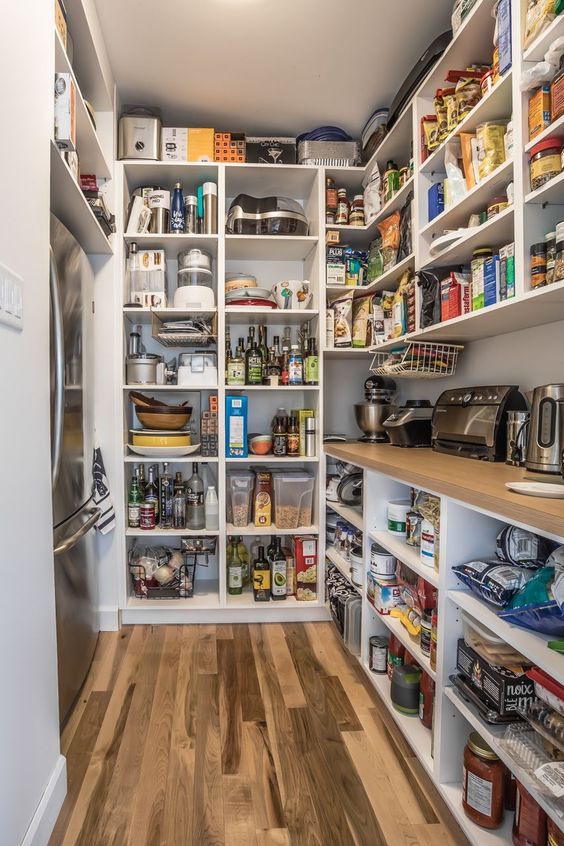
However, there are some drawbacks to consider:
- In smaller kitchens, carving out enough space for a separate pantry can be challenging. Innovative solutions like hidden shelves in niches or built-in corner cabinets might be required.
- The inconvenience of moving back and forth between the kitchen and pantry might be a drawback for some, as it involves carrying items and frequently opening and closing doors.
- Setting up and organizing a pantry requires additional money and effort. Proper shelving, drawers, and other organizational structures are necessary for a functional space.
- Regular cleaning and maintenance are essential to prevent the pantry from becoming a disorganized storage area filled with unnecessary items, spoiled food, and dust.
Ultimately, whether to set up a separate kitchen pantry depends on individual preferences, kitchen layout, and the need for additional storage space. For those with ample room and a need for extra storage, a well-organized pantry can be incredibly beneficial.

What Creates an Effective Kitchen Pantry?
A well-designed kitchen pantry primarily serves as a space for the long-term storage of food, which necessitates a specific microclimate and controlled temperature. Therefore, not every area in the kitchen or corridor is apt for setting up a pantry.
Adhering to specific conditions is essential:
- maintaining an air temperature between 10-15°C, occasionally up to 18°C
- avoiding direct and indirect sunlight and ultraviolet exposure
- keeping air humidity low, ideally around 40%
- ensuring robust forced ventilation without exposure to strong chemical smells.
Such an environment is ideal for preserving grains, flour, fruits, vegetables, spices, herbs, and home-canned goods.
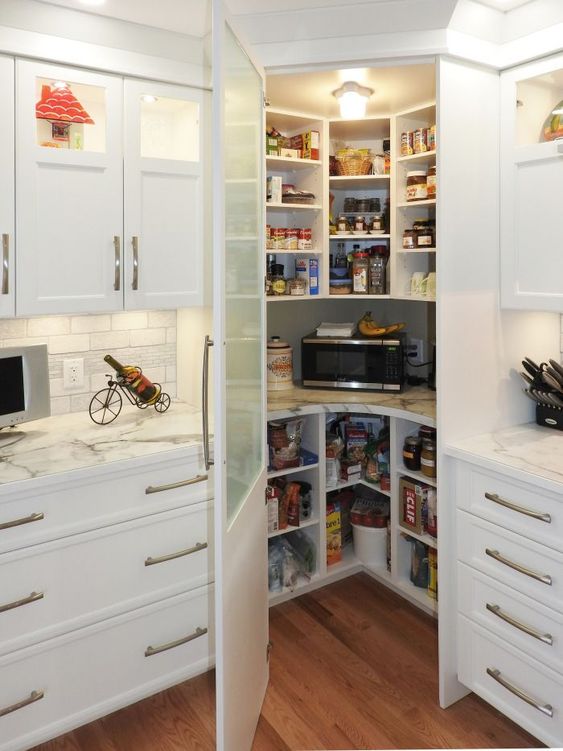
To achieve this, consider that:
- Heating should be minimal and only operational during winter. In well-insulated homes, extra heating might be unnecessary.
- The ideal placement is against a north or northwest wall in the kitchen that doesn’t receive direct sunlight. Alternatively, pantries in hallways or corridors near the entrance are practical for storing groceries or produce without carrying them through the entire house. Pantries with access to a garden or yard are typical in private residences.
- Select a room or kitchen area devoid of windows for the pantry. If a window is present, block out the light with dense roller blinds or blackout screens. Replace natural light with multi-level artificial lighting, ensuring all shelving units are well-lit with LED spotlights, and adjustable spots and track systems illuminate the lower tiers.
- Avoid storing items with strong odors, like gasoline, lubricants, acetone, or paint supplies, in the same space as food. Keep poisonous or hazardous materials, such as gardening chemicals or pesticides, out of the pantry.
In apartments with limited space and small kitchens, consider using built-in or freestanding cabinets and niches as alternative pantry solutions.
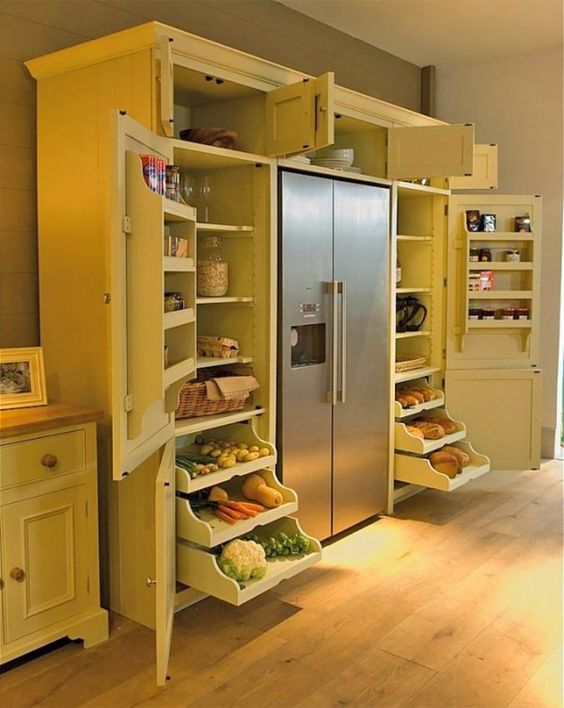
Selecting Materials and Equipment for a Kitchen Pantry
The pantry, serving as a utilitarian space demands specific considerations in its outfitting and design. Creating a comfortable and functional pantry that caters to the homeowner’s preferences and requirements hinges on thoughtful design choices and suitable materials.
- Materials that are practical and resistant to wear for the pantry’s walls, ceiling, and floor are ideal. Options like ceramic tiles, washable paint, artificial or natural stone, porcelain stoneware, and plastic panels are advisable. These materials are easy to clean and resistant to bacteria and mold growth.
- Shelving, cabinets, and racks should favor a minimalist style, avoiding ornate decorations and superfluous details to simplify cleaning.
- The internal components, including shelves and storage systems, should be crafted from materials that are easy to maintain and long-lasting. This includes galvanized steel and aluminum coated with powder paints. Moisture-resistant plywood, laminated particle boards, MDF boards, and shatter-resistant glass are also suitable. Wood elements can be added as removable drawers and sliding baskets.
- For those who prefer meticulous organization, closed cabinets and compartments, drawer units, and solid-front facades are recommended. Conversely, if easy access and visibility are priorities, open racks, shelving, and glass-fronted cabinets are better choices.
- Incorporate compartmentalized boxes, wall organizers, and multi-tiered storage systems with rotating mechanisms for organizing smaller items, bottles, and jars. Sliding doors, either in a coupe or accordion style, can enhance the usability of floor space.
- Organize the pantry using a variety of containers like wicker and metal baskets, bins, plastic containers, glass jars, and boxes. Opt for transparent containers and mesh baskets for easy visibility and quick access to contents.
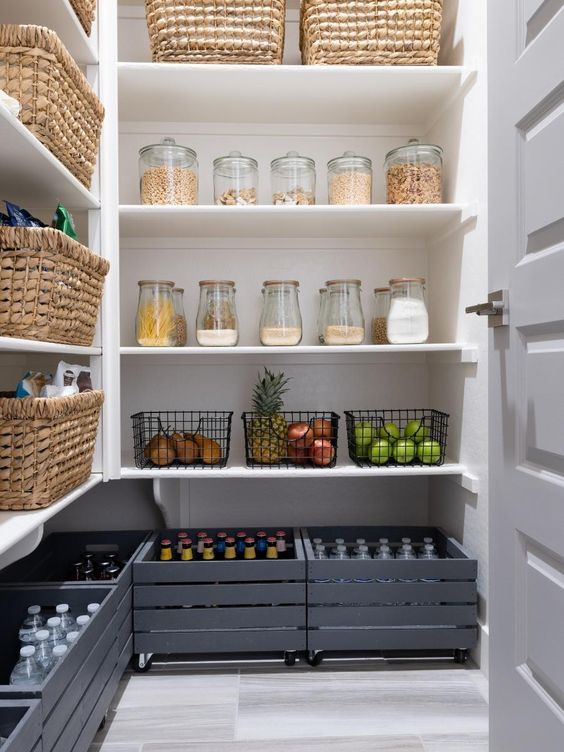
Maximizing Efficiency in Pantry Space
When dealing with limited pantry space yet having numerous kitchen items to store, meticulous planning is essential to ensure everything fits neatly. Though it might seem daunting initially, here are some strategies to optimize your pantry space effectively:
- Strategically divide the pantry into three horizontal zones, dedicating each to specific items. The top shelf should be reserved for infrequently used items like towels, tablecloths, napkins, or special-occasion dishes.
The middle section is ideal for everyday kitchen essentials. This area typically houses appliances like multicookers, coffee makers, blenders, meat grinders, bread makers, etc. It’s also a suitable spot for storing tea and coffee containers.
Use the bottom area for bulky and heavy items, such as fruit and vegetable boxes or containers with bulk products. - For deeper cabinets, consider installing rotating metal shelves mounted on a central vertical pole. These revolving shelves offer easy access to items at the back of the cabinet.
- You can also create a dedicated space within the pantry cabinet for breakfast preparation. This could involve arranging an electrical outlet for appliances like a coffee maker and toaster, set apart on a distinct shelf for convenience.
- Designate spaces or niches for a freezer and larger appliances, and plan for cabinets suitable for integrated devices.
- Construct the lower shelves, drawers, and cabinets with more depth while making the upper ones shallower. The total number of shelves and storage spaces should correspond to the quantity of kitchen items and products you intend to store.
- If the pantry is intended for perishable items like meat, fish, dairy, or frozen goods, ensure sufficient space for a refrigerator and freezer.
A well-organized pantry facilitates more brilliant grocery shopping and efficient trip planning to stores and markets but also aids in categorizing products by their expiration dates and types.
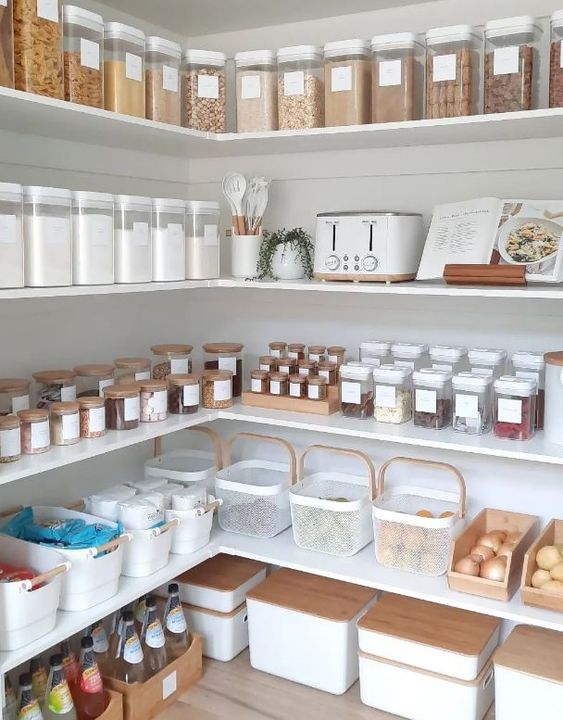
Variants of Well-Organized Pantries

A technical sink in the pantry is an excellent asset for meticulous homeowners. It’s perfect for washing shoes, cleaning home-canning jars, rinsing dirty vegetables, or preparing fish.
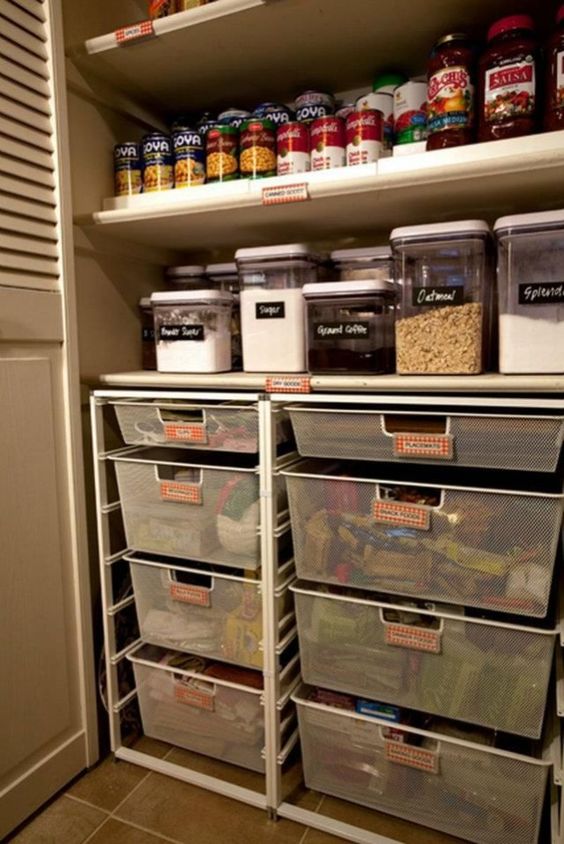
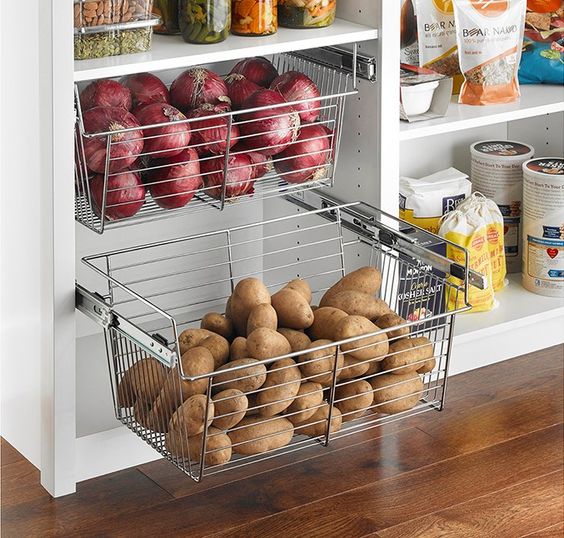
Pull-out storage systems are highly practical for pantries. They allow quick and easy access to items, with contents visible in open grid baskets and plastic boxes. This setup minimizes confusion. Store light-sensitive items in opaque-fronted boxes.
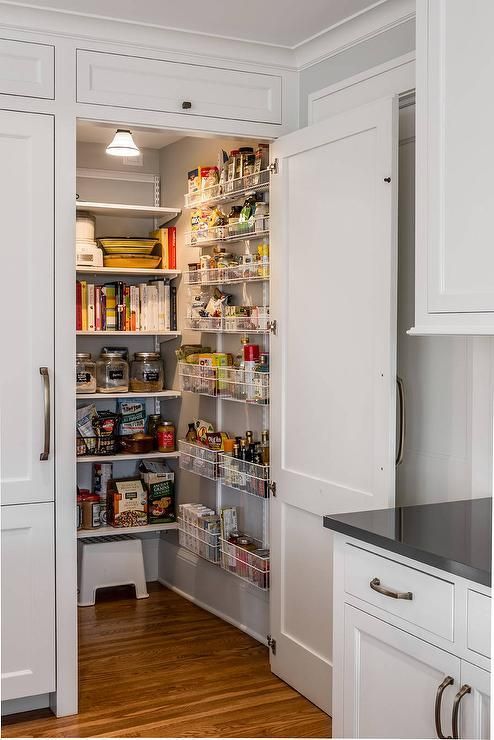
Modular metal shelving is a simple and swift solution for outfitting a pantry. These shelves are not only easy to install but are also sturdy and aesthetically pleasing.

This solution suits smaller kitchens well. Door-mounted shelves offer extra space for storing dry goods, spices, wines, and oils.
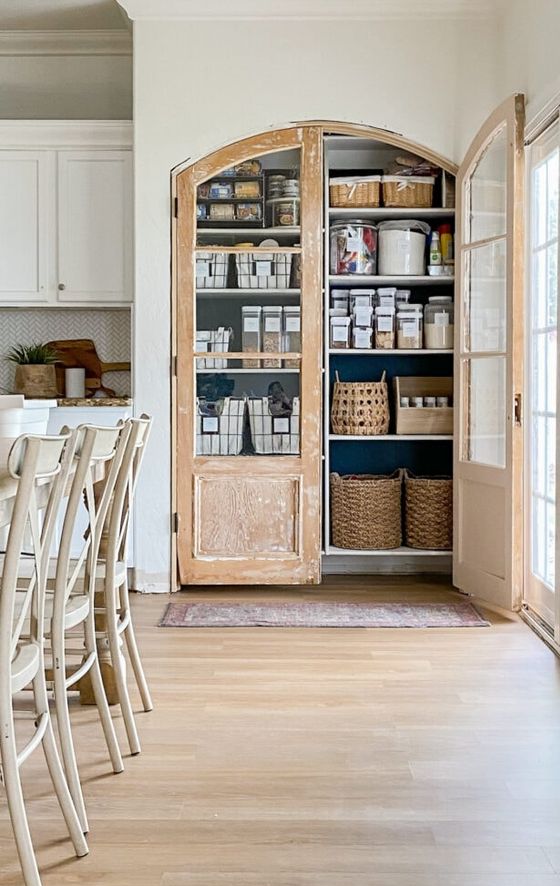
A niche pantry in the kitchen is an ideal choice for small apartments and studios. Its spacious shelves can accommodate a variety of items, from groceries to kitchenware, towels, and compact appliances.

A movable pantry cabinet is a versatile choice for smaller spaces. It can be relocated as needed and redesigned to match changing decor styles. Its internal arrangement caters to the specific needs of its users.

Innovative and ergonomic interior designs help keep the pantry meticulously organized. Varied solutions include pull-out boxes, and vertical storage systems

Some pantries feature a designated space for a table, making tasks like food preparation, sushi rolling, or repotting plants more convenient.
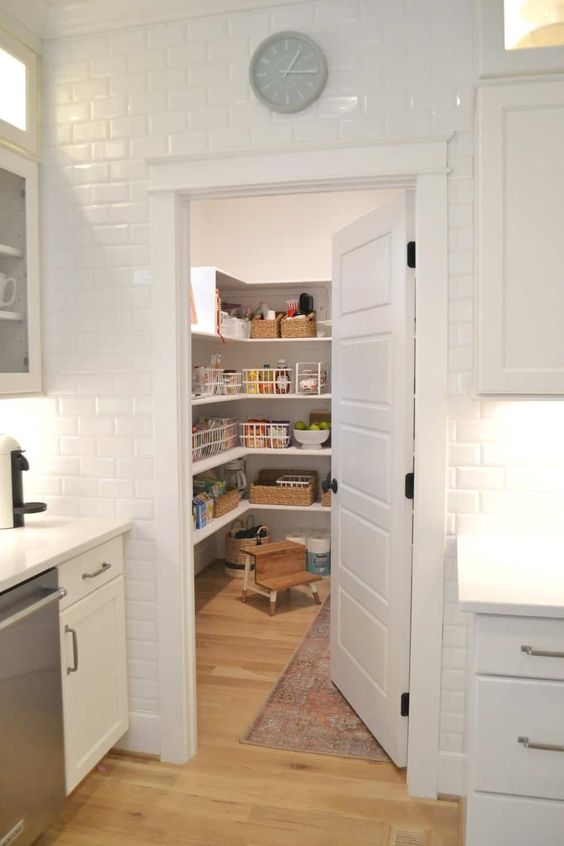
The pantry, a utility space, is often kept from guests’ view. Many homeowners opt for discreet door designs that blend with wall finishes or cabinet facades or use dense curtains for concealment.
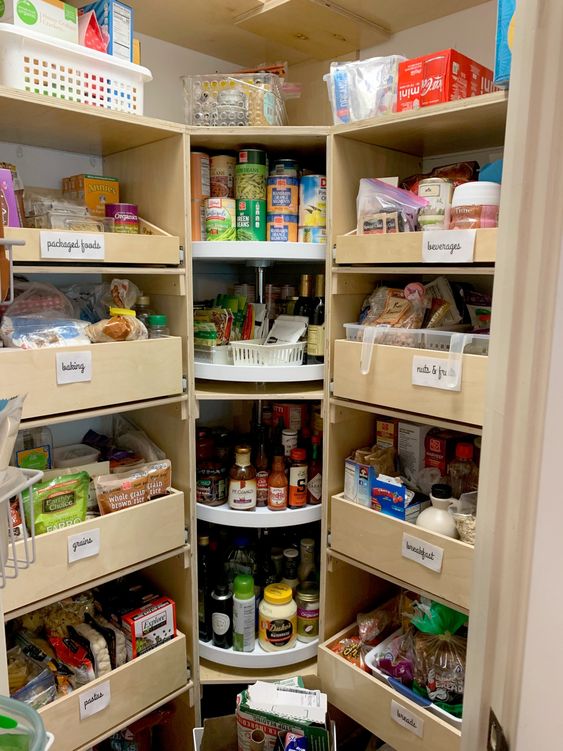
Innovative storage designs include rotating shelves for quick access to food and cleaning supplies.
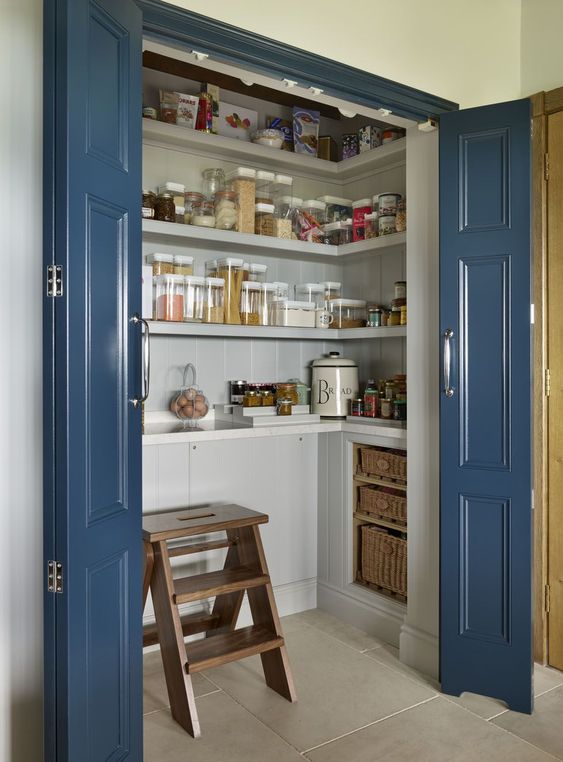
An ergonomically arranged pantry offers comfort and efficiency, simplifying the storage and retrieval of items. Its cohesive design is visually appealing and creates a positive atmosphere.
Therefore, experts advise paying close attention to every detail when setting up a pantry, from its location and shelving arrangement to the overall color scheme.
Deciding between an independent pantry and cabinets depends on personal preference and kitchen size; each offers unique advantages. A well-organized pantry enhances your kitchen’s functionality and contributes to a more spacious and orderly environment. Therefore, investing time and thought into designing a pantry that suits your needs and preferences is highly beneficial.
